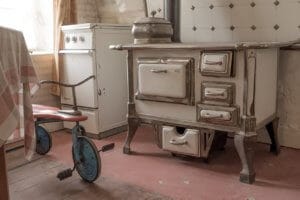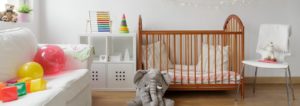If the electrical installation in your house is newly made, the socket protection is already present. This is not the case in older apartments. Here you should provide the socket with a child safety device before your child explores the apartment crawling. If your child’s fingers get into the socket, it can be life-threatening.
Here you can find out what you need to look out for in a childproof socket.
Table of contents
What Types Of Socket Protectors Are There And What Are They Good For?
In new buildings and new electrical installations, this is now standard. In the holes of the socket sits an almost invisible small cap made of plastic, which slides to the side when in use. Your child can’t get his fingers into it.
If you live in an apartment with older installations, you should retrofit the child safety device for the socket. But what are the options? Very widespread is the rotary lock. This child safety device is glued into the outer socket cover, the contacts are hidden.
- Also interesting:
- The best door safety gates
- The best stair guards
- The best sports buggies
Since the little covers are glued in place, they can’t be easily removed either. If you want to put a plug into the box, it’s a bit more complicated: You put the metal pins into the openings, apply an adequate amount of pressure and turn the plug together with the fuse until the pins slip through the fuse into the box.
However, this requires a fair amount of strength and skill – your child will not be able to bypass this childproof lock.
Other Forms Of Childproofing For The Socket Outlet
Easier than the twist lock for gluing in is the twist lock for plugging in. It can be removed again quickly if necessary. This is advantageous for you: You do not have to secure sockets that always have a plug in them.
Because the plugs are usually so tight that your child can’t pull them out by itself. But you also have sockets that you use occasionally.
You can secure these sockets with a glue-on childproof lock, but then you need a childproof lock for each socket. With the rotary fuse for plugging in, you do not need this. If the socket is currently occupied with a plug, it does not need to be secured. You use the fuse for an empty socket.
The fuse always goes where it is needed. This is especially practical if you use some rooms in the home only sporadically with your child and otherwise simply keep the door closed – your child can’t open the door on its own at first. The sockets in the room can therefore theoretically remain unsecured for the time being..
However, there is a problem with rotary fuses: The current VDE standard declares them unsafe. This is because the rotary fuses change the distance between the socket and the contacts of the plug.
It is possible that connected devices may overheat as a result, meaning that the child safety device generates a potential fire risk. For this reason, it is currently recommended to install sockets with integrated socket protectors. However, these sockets may only be installed by a specialist.
Socket Outlet Protection With Key For Installation
If you have sockets at a height that your child can reach and that you almost never use, you can also cover these sockets permanently. This is done with a child safety lock for the socket, which you must remove each time before using the socket.
The fuse is firmly attached to the socket with a key. Before using the socket, it must be removed with the same key.
A Bit Old-fashioned, But Efficient: The Hinged Lid
Actually, the hinged lid is not a child safety device for the socket, but a protection in general. The hinged lid can be opened upwards and is pressed onto the socket under tension by a spring.
It is difficult for children to open the hinged lid, so they cannot simply reach into the socket. However, there are children who can do this. And once the lid is up, the child safety feature is gone. Hinged lids are considered less safe than other options.
You Should Install A Child Safety Device In Every Socket That Your Child Can Reach
Your child mimics what you do. So they will first be interested in the sockets that you use all the time. However, you must always be prepared for your child to explore on his own. He won’t ask you if he can examine the wall here or crawl into the hallway.
So you should really secure all sockets that your child can reach. Expect that the child will be able to pull himself up the wall and furniture very quickly. He will learn in no time to climb onto a chair, climb from the chair onto the kitchen countertop and knock over the knife block there. And, of course, it will discover the sockets behind it. So pay attention to child safety in the kitchen as well.
So it’s not enough just to fit the sockets up to knee height everywhere in the home with a socket safety device. You can save yourself the child-proofing for the socket if you put heavy children’s room furniture in front of the sockets that you don’t use anyway.
You can also lock the sockets you don’t need. The above-mentioned socket protector with a key is a good solution. Also remember that your child is learning to open doors.
He may not be able to reach every room at first, but soon he’ll really want to get to know the apartment, and he’ll be walking. Then it’s not hard for most kids to open doors.
What Exactly Does The Child Safety Lock In The Socket?
The child safety device for the socket is designed to cover the contact openings. Children like to play, and most children are not aware of the dangers of an electrical outlet. If the finger does not fit into the small opening, many children also try out whether needles, screwdrivers, pens, hair clips or other objects fit in there. So a very small opening is also no guarantee that the socket is safe for children.
It becomes particularly dangerous when children catch objects made of metal for their experiments or bring other conductive materials to the contacts. Some types of children’s plasticine, for example, also conduct electricity – for children, such experiments can be fatal. That’s why it’s so important to put a child safety device in every electrical outlet. The socket protector is designed to increase safety at home.
The protectors for sockets are available both in electrical stores and in toy stores and supermarkets and hardware stores. Where you buy the fuse has no bearing on how safe the product really is.
Permanent protection is rated as very sich for unused sockets. This fuse consists of a plug-like plastic part. The round part is inserted into the socket and sits there so tightly that children cannot remove it. You need some kind of key to remove the part again.
Sockets With Integrated Child Safety Locks Are A More Flexible Solution
You are a bit more flexible with sockets that have an integrated fuse. The flaps that sit inside the socket above the contacts can only be moved to the side if you apply pressure to both plastic plates with a plug at the same time.
These small plates are so tight that none of them can be pushed aside even with brute force – at least not with the means available to a small child.
For you, this means that you have to push the plug into the socket so slowly and evenly with a little force that you actually bypass the child safety lock. This requires a bit of skill on your part – so in a way, the childproof lock also makes the socket safe for parents.
If you enter the search terms “child safety socket” in Google, you will find a lot of forum entries from irritated parents: They sometimes doubt that the socket with integrated child safety is still usable at all.
When Buying, Look Out For Product Labels And Safety Seals
A CE mark may not be given on the child safety lock for the socket. This is because, according to Directive 2014/35/EU, CE product marking is only permitted for electrical equipment.
However, a child safety lock for the socket outlet is not electrical equipment, but mechanical protection used in conjunction with electrical equipment. This sounds more complicated than it is: CE product marking may only be given to electrical equipment.
These are devices that are operated with electric current. The child safety lock for the socket is not operated with electric current. It prevents electricity from flowing through contacts.
GS Mark For Child Safety Lock For The Socket Also Not Allowed
The child safety locks are also not allowed to carry a GS mark because they are not electrical devices. This was decided by the Experience Exchange Group of the National Testing Authorities (EK 1).
And the VDE standard VDE 0620-1 has meanwhile decided that the use of child safety devices in the form of insert and adhesive plates is no longer permissible before the legislator – this form of socket fuse is considered too unsafe. The possible increased risk of fire during operation of the devices connected to such a secured socket has already been mentioned.
For safety reasons, it must be pointed out that child safety devices subsequently installed in the sockets should no longer be used. Consumers should generally no longer use the adhesive plates and insert plates with rotary mechanism.
The German manufacturers of these fuses have therefore discontinued production. If you still have remaining stocks of these insert and adhesive plates at home, please do not use them. Because these plates sometimes jam. In this case you should not use force.
If the plate breaks or suffers some other kind of damage, it is more dangerous than no socket protection at all. By the way, manufacturers point out that even built-in child safety devices cannot guarantee 100% protection.
Safety Measures Go Beyond Securing Easily Accessible Sockets
So you should always supervise your child well and make sure they don’t play around with the outlets in the house. It’s true that children are sometimes curious and don’t obey everything their parents ask.
Nevertheless, it is quite possible to teach children to accept prohibitions even at a young age. Make sure that you are a good role model for your child: Only the plugs of electrical devices belong in the socket. Always have sockets replaced and/or repaired by qualified personnel only!
Conclusion: Always Be With The Child
The child safety lock for the socket is one way to make the sockets in the house reasonably safe. But even with the child safety lock in the socket, you must of course not leave your child unsupervised.
Because no outlet protector is really a guarantee that your child will not come to harm. In new houses, the child safety device is integrated into the socket. The well-known German manufacturers only offer sockets with protection already built in.
In older properties with an electrical installation that is not quite up to date, these fuses are not present. Until now, it was common practice to install insert plates or adhesive plates in the socket. These fuse plates are no longer permitted, and their use is discouraged.
This is because the plates change the distance between the contacts and the devices. This is associated with an increased risk of fire.













2 thoughts on “What Types Of Childproof Lock Socket Are There?”